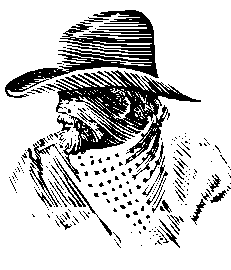|
The James Brothers
RIDING THE OUTLAW TRAIL Herald Democrat

One of the lesser known or perhaps lesser admitted sides of the history of
Sherman and Grayson County, is the area’s close connection to the lives and
careers of the legendary Missouri outlaws Jesse and Frank James.
The connection began in the early days of the Civil War with the activities of William Clarke Quantrell, notorious border guerrilla chief, and continued beyond the death of Jesse James at the hand of Robert Ford in 1882. … originally from Ohio, but living on the eve of the Civil War, near Preston Bend in Grayson County. Using the alias of Charlie Hart, instead of his own name, William Clarke Quantrell came down from the Missouri-Kansas border in March 1861 to visit his relatives. He was already established as a player in the violent classes in “Bleeding Kansas“. All along the border and into Missouri the ongoing skirmishes, often by paramilitary groups, unfettered by ties to the regular military establishment, north or south, had produced a landscape sullied by the bitterness of mutually destructive warfare. He took notice of a population generally sympathetic to the southern cause, the good water and grass and an abundance of hiding places in the back country away from town. This information might serve him well in the future. Indeed it did. The following fall, in November of 1862, Quantrell came back to Sherman with about twenty-five Missouri guerrillas. They spent a quiet winter in the city before riding north in the spring and into the blacker pages of history. These came, when the loosely organized guerrilla band, now numbering over 200 hard case ruffians and veterans of the border wars, sacked the Unionist town of Lawrence, Kansas, murdering 150 men and boys of military age and at Baxter Springs, also in Kansas, where they cut up a Union army detachment in a stand-up fight. Riding with Quantrell were named destined to be written in blood across the history of the American Midwest – William T. Anderson, known as “Bloody Bill”; Frank James of Clay County Missouri and the Younger clan led by eldest brother, Cole. These men, along with about 200 more, including Frank James’ younger brother Jesse, not yet old enough to be a combatant, accompanied Quantrell when the band descended on Sherman in November of 1863 to winter away from the war. This time, the stay was not so quiet. In a telegram to Edmund Kirby Smith, chief of the southern armies in the Trans-Mississippi, he noted, “News of a reliable character reached me this morning that Jayhawkers (irregular Kansas unionist guerrillas) in considerable force had penetrated Gainesville … Indians and Federals 400 strong. I sent all the cavalry force I had this morning at 8 o’clock, numbering only some 200 men from this place, directing Quantrell, from Sherman, to meet them at once.” Quantrell, not beholding to Confederate authority, refused to join the Confederate troopers. Instead he led his men across the Red River into the Indian Territory where they carefully prepared an ambush for the invading Federals. The blue coats, trying to avoid McCullough’s column, blundered into the raiders and were cut to pieces. The next day, the victorious guerrillas celebrated their victory by shooting up Sherman in a drunken orgy of wine, women and gunpowder. While no residents were hurt, the town took a beating. Then the celebrants crashed the Christmas party in Ben Christian’s hotel, several gunmen took turns shooting the tassels off matriarch Sophie Porter’s bonnet. As the spring of 1864 came .., Quantrell’s continued presence in Sherman became a drain on the city and a thorn in the side of General McCullouch in Bonham. The idea of a large body of well-armed men in his territory, men whose loyalties and alms were questionable at best, bothered the general. The guerrilla chief was having problems of his own that spring. His group was beginning to disintegrate. Never tightly organized, the raiders began to break up and drift off in different directions, oblivious to the needs of their erstwhile commander in the military situation. In March, against Quantrell’s wishes, Bill Anderson married a Sherman girl, Bush Smith, and set up his own attachment near College and Boughton streets. He was soon to go back to Kansas and follow his career of murder and mayhem and to meet his death. About that time, General McCullouch ordered Quantrell to meet him in Bonham. When the raider arrived, he was arrested and jailed. He did not stay arrested for long. Escaping and making his way back to Sherman, Quantrell gathered all who would follow him, only 14 of the original 200 or so who had trooped in to Sherman the previous fall. They headed for Kentucky. There he died at the hands of Union soldiers. Time had run out for the enigmatic shooting star that was William Clarke Quantrell. Not so his influence. At the close of the war, one of his chief lieutenants, William H. Gregg, led a bedraggled contingent of 50 refugee Missouri families on a harrowing trek through the Indian Territory to new lives in and around Sherman. In 1868, Cole and Jim Younger brought their ailing mother from Missouri to a new home in Scyene near Dallas. They spent several weeks in Sherman with friends, passing much of their time at the infamous saloon and brothel run by ex-raider Jim Crow Chile. The year of 1870 brought the Youngers back to Sherman, this time posing as cattle brokers. They charmed the community by singing in various church choirs with Jim Younger accompanying their great repertoire of hymns on his fiddle. In the interim, they swindled a number of local investors and, pockets filled with Sherman gold, returned to Missouri.
By the early 1870s, the James gang, now led by Frank’s little brother, Jesse, had made a name for itself in the banking and railroad circles of their native Missouri. In November of 1873, one of the gang members and former Quantrell guerrilla, Allen Parmer, married Jesse and Frank’s sister, Susan Lavenia James, in Missouri. The couple moved to Sherman where they settled on a farm on Post Oak Creek. Susan became a school teacher in her new home town. Jessie married his cousin, Zeralda Mimms, in April 1874, and the newlyweds honeymooned in Sherman, staying with the Parmers. Over the next several years, the Jameses made numerous trips to the area to visit friends and relatives and to find a cooler atmosphere than the increasingly hot Missouri situation offered. Things turned sour for the outlaws and the disastrous foray into Northfield, Minnesota, on September 7, 1876. Surprised when the citizens of the town took up arms and fought the robbers, the raid against the town’s two banks proved a catastrophe for the gang. Clell Miller and William Stiles were killed ... Cole, Bob and Jim Younger were wounded and captured. Only Frank and Jesse made good their escape back to Missouri. After Northfield, the James curtailed their larcenous ways for a while. While in Sherman in February of 1877, Jesse took a job as an adjunct Grayson County deputy to help a posse led by Sheriff W. C. Everheart run the Jim Baxter gang to ground. Whether Jesse accepted the post out of civic responsibility, not a likely choice, or the opportunity to eliminate some of his business opposition, a more likely suggestion, it was never known for sure. Texas was generally a friendly place to the outlaws through most of the 1870s. Still smarting from a harsh reconstruction and a long tally of misdeeds committed by the carpetbaggers and scalawag administration in Austin, Texans were reluctant to turn on former friends and allies, whatever their sins committed out of Texas and against the Yankees might be. That attitude was coming to an end, however. In October 1879 the gang staged a big comeback by robbing a Chicago & Alto train near Glendale, Missouri, and making off with $40,000. Later that month, Grayson County Sheriff Everheart, the same lawman who had welcomed Jesse’s services two years earlier, arrested Jesse’s brother-in-law, Allen Parmer, for the Glendale holdup and sent him back to Missouri to stand trial. The safe haven in Sherman was gone for good. Not quite gone was the Quantrell-James-Younger connection, however. Six years after Jesse’s death, in October of 1888, the first official reunion of the Quantrell raiders was held at the Binkley Hotel in Sherman. Quantrell was long dead, as was “Bloody Bill” Anderson and many more, the remaining Youngers were behind the walls of Stillwater Prison in Minnesota, but among the 26 men who attended the affair were Frank James and Allen Parmer – the last of the group that for a while, no so long ago, made Sherman “Helldorado on the Crosstimbers.” 
Famous & Infamous Copyright © 2025, TXGenWeb.. If you find any of Grayson County, TXGenWeb links inoperable, please send me a message. |